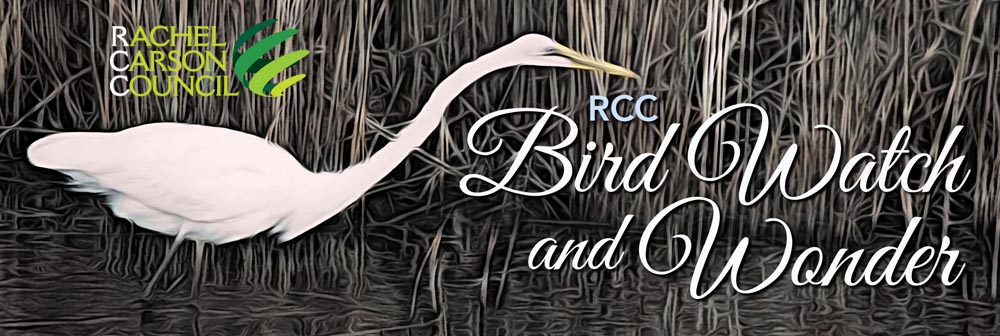 | Rachel Carson Council Launches
Bird Watch and Wonder Newsletter 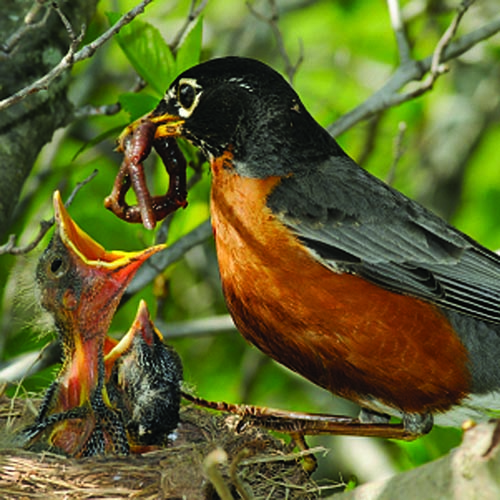 With Silent Spring (1962), Rachel Carson alerted Americans to the threat of a time, in the words of Keats, when “no birds sing.” The beloved American Robin, the harbinger of spring, was dying on lawns, on campus quadrangles, on the front porch of families. The majestic bald eagle, soaring ospreys, and the spectacularly swift Peregrine Falcon were endangered, too. With Silent Spring (1962), Rachel Carson alerted Americans to the threat of a time, in the words of Keats, when “no birds sing.” The beloved American Robin, the harbinger of spring, was dying on lawns, on campus quadrangles, on the front porch of families. The majestic bald eagle, soaring ospreys, and the spectacularly swift Peregrine Falcon were endangered, too.
Carson aroused the public, stirred an environmental movement. The Rachel Carson Council, many, many other organizations, writers, scientists, and ordinary citizens were moved to action. DDT and similar pesticides and herbicides were banned. The Clean Air, Clear Water, Endangered Species, and other acts were passed. The EPA was formed. The birds and their habitat, their songs and beauty were protected, as was the health of humans, which, as Carson showed, is inseparable from that of birds and bees and beasts. The RCC Bird Watch and Wonder program seeks to protect today’s birds and preserve and protect the ecosystems, the very planet, on which they and we depend. Since the 1970s, the number of North American birds has declined by some 30%. Global climate change, rampant development and sprawl, the continued use of toxic chemicals, the decline in insects, the toll from cars and towering buildings are among the culprits. In this our inaugural issue of Watch and Wonder, you'll find films, books, resources, art and the latest news and articles reflecting the RCC's unique blend of sound science, awe and wonder at the beauty of birds and their world, and advocacy and action to preserve and protect what we love. | | 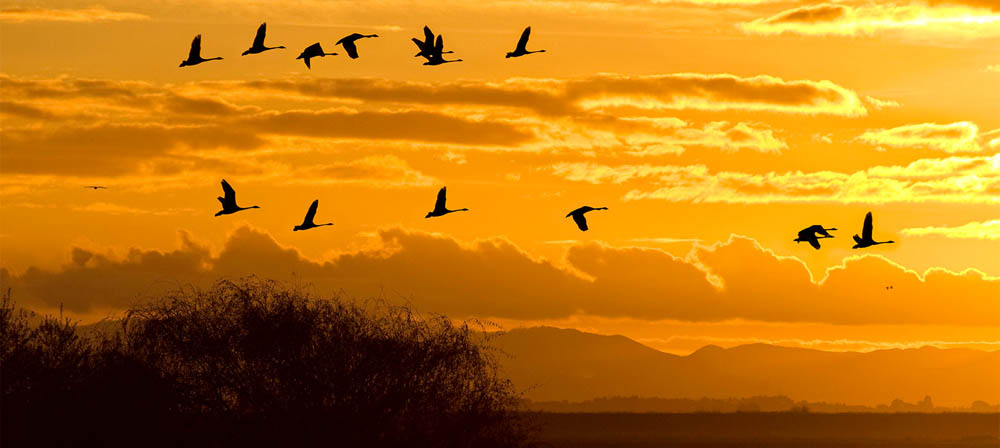 | | | Farms, Feathers, and Fins Share Water in California | | A Coalition of Conservation Non-profits is Creating
Innovative Ways to Put Farmland to Work Supporting Wildlife. From the air, California’s Central Valley looks like an enormous patchwork quilt, squares of green and gold fields stitched together by grey threads of roads and highways. This region is known as “the breadbasket of the world.” The rich alluvial soil produces a quarter of the nation’s food. Close to 20% of all the rice grown in the U.S. comes from here. This region and its water are also crucial to another group: migratory birds. Far above the roads that thread the Central Valley landscape is an enormous aerial freeway known as the Pacific Flyway. Tens of millions of migratory birds travel thousands of miles up and down this superhighway in the sky each year. Some make the heroic journey from their arctic breeding grounds in Alaska or Canada to as far south as Ecuador or Chile. Read more | | | | Sounds of Silence: The Extinction Crisis Is Taking Away the Earth's Music 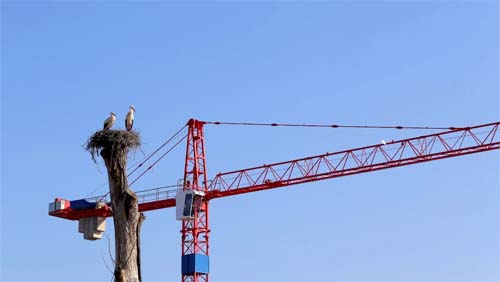 In the past 50 years, America's bird populations have fallen by a third, and worldwide the average mammal population has dropped 60%, writes acclaimed environmental philosopher and nature writer Kathleen Dean Moore in her new collection of essays, Earth's Wild Music: Celebrating and Defending the Songs of the Natural World. In the past 50 years, America's bird populations have fallen by a third, and worldwide the average mammal population has dropped 60%, writes acclaimed environmental philosopher and nature writer Kathleen Dean Moore in her new collection of essays, Earth's Wild Music: Celebrating and Defending the Songs of the Natural World.
And with all that loss comes an unsettling silence. "Unless the world acts to stop extinctions, I will write my last nature essay on a planet that is less than half as song-graced and life-drenched as the one where I began to write," she explains in the book's preface. Read more | | | | 10 Fun Facts About the Barred Owl 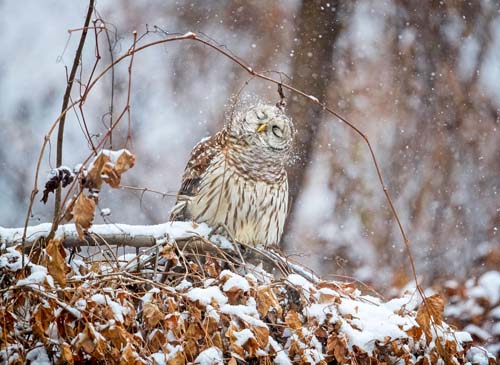 Maniacal laughter. Pink wings. Tree climbing. This bird has a lot going on. Maniacal laughter. Pink wings. Tree climbing. This bird has a lot going on.
A large owl of the eastern, central, and, increasingly, northwestern United States, the Barred Owl is one of our more common owl species. As with most owls, the Barred is primarily nocturnal, but it is known to call and hunt during the day. Easily identified by its heavily streaked chest, round, tuftless head, and big, black eyes, the Barred Owl can be found in forested areas throughout its range year-round, including in more urban environments. Learn more about this bird, and when you're done, check out these other fun facts about owls. Read more | | | | Next Steps Announced in Process to Reinstate and Strengthen Migratory Bird Treaty Act 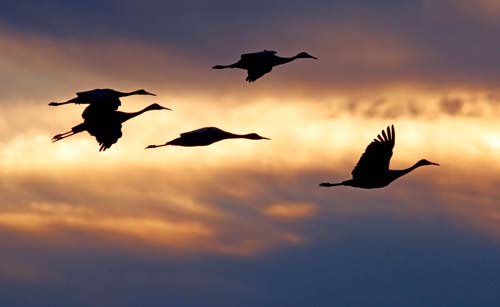 The Trump administration’s final rule will go into effect today, but a new rulemaking process will begin that is expected to bring back critical bird protections. The Trump administration’s final rule will go into effect today, but a new rulemaking process will begin that is expected to bring back critical bird protections.
“Today’s announcement sends an important signal that the administration will move to reinstate protections for migratory birds,” said Sarah Greenberger, senior vice president for conservation policy, National Audubon Society. “The moves announced by the Department of the Interior create a critical opportunity to strengthen the century-old law for the future. Read more | | | | Shade-Grown Coffee Could Help Save Birds, If Only People Knew About It 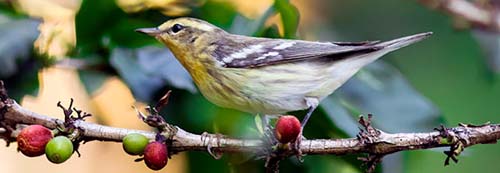 The message about the bird-conservation benefits of shade-grown coffee may not be getting through to the people most likely to respond—birdwatchers. A team of researchers from the Cornell Lab of Ornithology and Virginia Tech surveyed birdwatchers to learn if they drank shade-grown coffee and, if not, why not. Their findings were published today in the journal People and Nature. The message about the bird-conservation benefits of shade-grown coffee may not be getting through to the people most likely to respond—birdwatchers. A team of researchers from the Cornell Lab of Ornithology and Virginia Tech surveyed birdwatchers to learn if they drank shade-grown coffee and, if not, why not. Their findings were published today in the journal People and Nature. “One of the most significant constraints to purchasing bird-friendly coffee among those surveyed was a lack of awareness,” said Alicia Williams. Read more | | | | Birds and Climate Change 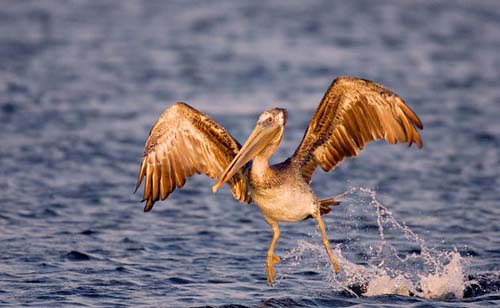 The results are clear – birds need our help, and they need it now. The results are clear – birds need our help, and they need it now.
Every bird species has unique characteristics that enable it to thrive.
If climactic conditions of their living environment become too hot or too cold, or too wet or too dry due to changes sparked by climate change, birds may have difficulty adapting quick enough to survive within their natural range. Audubon’s data shows that birds are on the move due to climate change. But will they have a safe place to land? Read more | | | | Steller’s Jay: What’s In A Name? 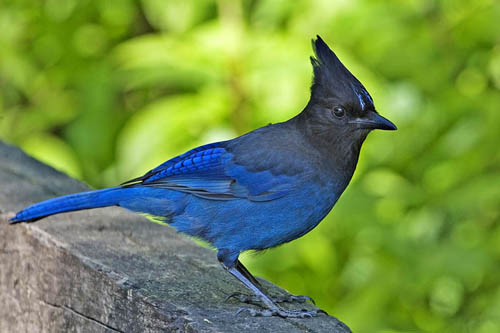 Although I’ve been a birder since junior high (the term junior high should date me), I usually didn’t give much thought to the person a bird was named after. Of course, Although I’ve been a birder since junior high (the term junior high should date me), I usually didn’t give much thought to the person a bird was named after. Of course,
I knew about Audubon and some others, but didn’t really think much about the contributions of people like Anna Blackburne, an English botanist in the 1700’s (Blackburnian Warbler) or Georg Steller, an 18th-century German botanist, zoologist, physician, and explorer.
(Steller’s Jay). While recently reading Island of the Blue Foxes: Disaster and Triumph on the World’s Greatest Scientific Expedition, a spellbinding book by Stephen R. Brown, I realized that one of the scientific members of the expedition was Georg Steller, the namesake of the Steller’s Jay. Read more | | | | The Happiness I’ve Discovered in My Backyard 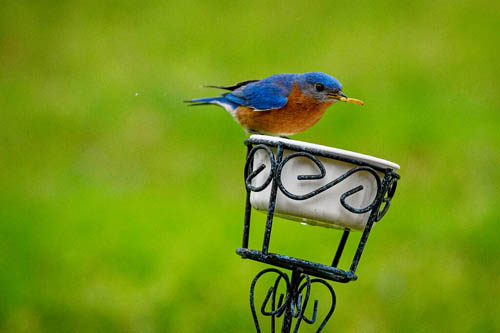 This year isn’t living up to my hopes, so I am learning to hope in a new way. This year isn’t living up to my hopes, so I am learning to hope in a new way.
Almost every winter morning, the same avian drama plays out in my yard as soon as I walk to the back door. If the neighborhood bluebirds are anywhere nearby, one of them will spot me standing behind the glass and fly expectantly into the bare branches of the closest maple. Then the rest of the flock will join the sentry, and soon the sleeping tree is bedazzled by bluebirds. They are carrying the sky on their backs, just as Thoreau observed. Read more | | | | Something is Killing California’s Songbirds 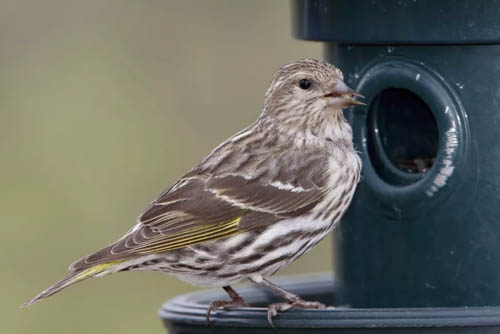 Officials are urging people to take down their feeders, where birds are congregating and spreading a bacterial infection. Officials are urging people to take down their feeders, where birds are congregating and spreading a bacterial infection.
Songbirds are dying across parts of California and the Pacific Northwest, and officials think crowds at bird feeders are to blame, according to recent news reports.
The California Department of Fish and Wildlife (CDFW) and wildlife rehabilitation centers have been “inundated” with calls since December 2020 from California residents reporting that they found sick or dead finches at their bird feeders, according to a statement posted Feb. 8. Read more | | | | Audubon at Sea 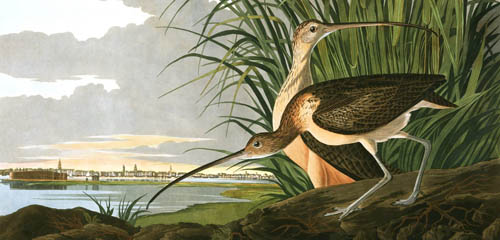 Famous for his art and writing about birds—and infamous more recently for his racist views—John James Audubon traversed the Atlantic a dozen times, providing a snapshot into the state of the ocean two centuries ago. Famous for his art and writing about birds—and infamous more recently for his racist views—John James Audubon traversed the Atlantic a dozen times, providing a snapshot into the state of the ocean two centuries ago.
On the bustling docks of New Orleans, Louisiana, just before he boarded the merchant ship Delos and left to cross the Atlantic, John James Audubon purchased a baby alligator for a dollar. He likely thought the animal would be fun to draw, and the live specimen might impress the naturalists of Britain when he delivered his paper “Observations of the Natural History of the Alligator.” Read more | | | | Reverse Bird Declines: Boost Conservation Programs 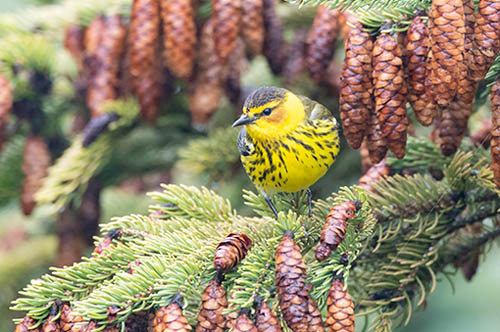 As the new Congress begins we are happy to report that your voice was heard by the 116th Congress. In total, bird conservation programs received a substantial $26 million increase. This is a great start. Now we need to raise our voices again and make sure that conservation programs get the funding needed to reverse bird declines. As the new Congress begins we are happy to report that your voice was heard by the 116th Congress. In total, bird conservation programs received a substantial $26 million increase. This is a great start. Now we need to raise our voices again and make sure that conservation programs get the funding needed to reverse bird declines.
The loss of bird populations in North America continues to be alarming. Habitat loss, collisions with glass, and climate change all pose serious threats to birds, and adequately-funded federal conservation programs are critically needed to address these issues. Speak up to ensure that federal conservation programs have the resources needed to protect birds. Click here to Take Action | | | | What a Songbird Lost at Sea Taught Me About Survival 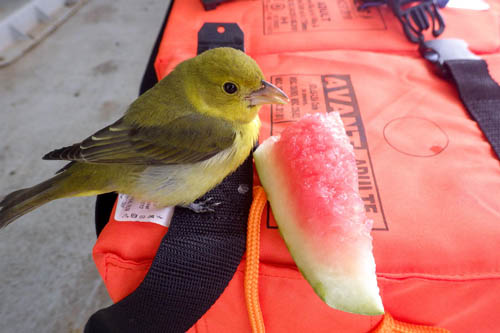 Aboard a mission to explore the alien life of the deep ocean, a chance encounter with a migratory bird offered a point of connection—one that has felt poignant this past year. Aboard a mission to explore the alien life of the deep ocean, a chance encounter with a migratory bird offered a point of connection—one that has felt poignant this past year.
The bird was olive-green and yellow with a chunky beak. No one knew where she came from. But she probably wasn’t supposed to be here. She just appeared one day, tattered and listless. She must have been flying quite some time before she found us. On our steel island, songbirds didn’t drop from the sky every day. For weeks the R/V Atlantis had been stationed on the open sea some 40 miles from shore. Erik Cordes, an ecologist at Temple University, was leading a team of scientists from about half a dozen labs on a mission to explore life along the continental margin in the Pacific Ocean. Read more | | | | Spark Bird  If I can be called a bird-watcher, my spark was a pair of burrowing owls, painted on the narrow storefront gate of a shuttered real estate business on 145th Street in Harlem that brokers single-room occupancy housing for two hundred dollars a week. I spotted them after ice-skating with one of my kids at the rink in the shadow of towering smokestacks at Riverbank State Park. The park is a concession to the community for the massive wastewater sewage plant hidden beneath it. It was midway through the Trump years: January, but not cold like Januaries when I was little, not cold enough to see your breath. It wasn’t snowing, and it wasn’t going to snow. The owls watched me quizzically with their heads cocked, their long skinny legs perched on the colored bands of a psychedelic rainbow that seemed to lead off that gray street into another, more magical realm. Read more If I can be called a bird-watcher, my spark was a pair of burrowing owls, painted on the narrow storefront gate of a shuttered real estate business on 145th Street in Harlem that brokers single-room occupancy housing for two hundred dollars a week. I spotted them after ice-skating with one of my kids at the rink in the shadow of towering smokestacks at Riverbank State Park. The park is a concession to the community for the massive wastewater sewage plant hidden beneath it. It was midway through the Trump years: January, but not cold like Januaries when I was little, not cold enough to see your breath. It wasn’t snowing, and it wasn’t going to snow. The owls watched me quizzically with their heads cocked, their long skinny legs perched on the colored bands of a psychedelic rainbow that seemed to lead off that gray street into another, more magical realm. Read more | | | | Indigenous Tribe Leads Efforts to Reintroduce Condors to Pacific Northwest 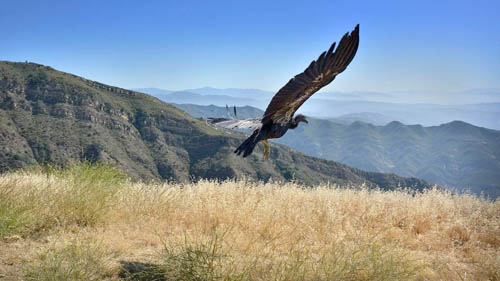 The California condor once ranged from Mexico in the south to Canada's British Columbia in the north, but hunting, habitat loss and poisoning drove the species to the brink of extinction. The California condor once ranged from Mexico in the south to Canada's British Columbia in the north, but hunting, habitat loss and poisoning drove the species to the brink of extinction.
The birds have begun to make a recovery in the southwestern portion of their historic range and now, thanks largely to the efforts of the Yurok Tribe, they will fly over the Pacific Northwest once more. "As soon as I heard the news, I started crying," Yurok Tribe wildlife department director Tiana Williams-Claussen told OPB. "This is something that I've been working for literally my entire adult career." Read more | | | | Composers, Scientists, Designers Update Vivaldi's 'Four Seasons' For an Era of Climate Change 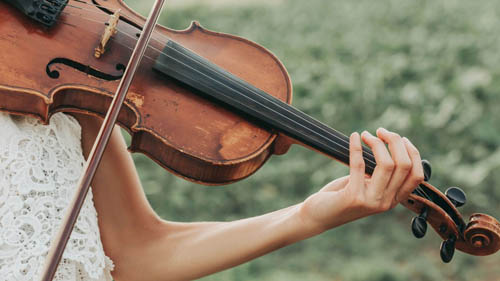 The result is familiar but unsettling. The result is familiar but unsettling.
Three hundred years ago, Vivaldi wrote “The Four Seasons.” It portrays the natural world, from birdsong to summer storms.
But the warming climate could radically alter the natural world by 2050, so a new version of “The Four Seasons” has been altered, too. “We really wanted to walk that line between being too ridiculously catastrophic and kind of meaningfully changing this to make it sound what we think it might feel like to live in that time,” says Tim Devine of AKQA. Read more and listen | | | | How Can I Keep Birds From Hitting My Windows? 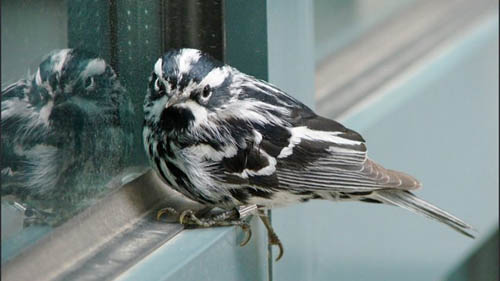 After cats, windows are one of the deadliest threats to birds in America. Researchers estimate that between 100 million and 1 billion birds are killed by colliding with glass every year, in the United States alone. After cats, windows are one of the deadliest threats to birds in America. Researchers estimate that between 100 million and 1 billion birds are killed by colliding with glass every year, in the United States alone.
If you’re selecting new windows while building or remodeling, if at all possible choose double-hung windows or other types with the window screens on the outside. If you’re putting up a large picture window and like the effect of small panes, putting dividers on the outside as well as the inside will also help. But most of us are stuck with the windows we already have, or are limited in our options in selecting new windows. Sticking one or two decals on a window will not help. You might try one of these techniques, ranked roughly from most to least effective. Read more | | | | Reverse Bird Declines: Boost Conservation Programs 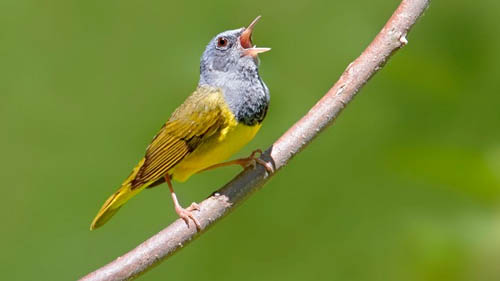 As the new Congress begins we are happy to report that your voice was heard by the 116th Congress. In total, bird conservation programs received a substantial $26 million increase. This is a great start. Now we need to raise our voices again and make sure that conservation programs get the funding needed to reverse bird declines. As the new Congress begins we are happy to report that your voice was heard by the 116th Congress. In total, bird conservation programs received a substantial $26 million increase. This is a great start. Now we need to raise our voices again and make sure that conservation programs get the funding needed to reverse bird declines.
The loss of bird populations in North America continues to be alarming. Habitat loss, collisions with glass, and climate change all pose serious threats to birds, and adequately-funded federal conservation programs are critically needed to address these issues. Speak up to ensure that federal conservation programs have the resources needed to protect birds. Click here to Take Action | | | | | | BOOK REVIEWS Christian Cooper on a New Book That Asks:
Why Are Migratory Birds Vanishing? World on the Wing
The Global Odyssey of Migratory Birds By Scott Weidensaul 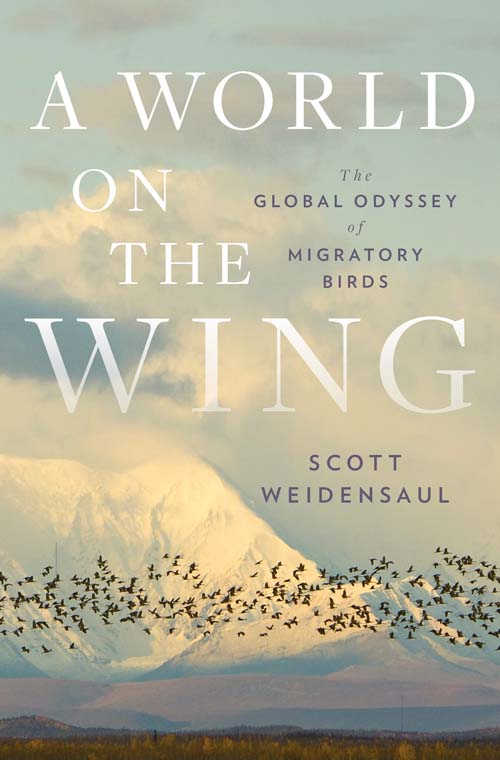 “Given the state of migratory birds around the world, I needed a little good news.” “Given the state of migratory birds around the world, I needed a little good news.”
Coming near the end of “A World on the Wing: The Global Odyssey of Migratory Birds” — Scott Weidensaul’s gripping journey alongside the world’s feathered wanderers and the people who study them — these words are necessarily grim. Any longtime birder offers the same lament: Migration just isn’t what it used to be.
The plummeting numbers of songbirds and shorebirds, raptors and waterfowl, have become painfully apparent; a recent study collating decades of data revealed that nearly a third of all birds — three billion creatures — have vanished from North America in just the last 30 years. Weidensaul tasks himself with communicating to both the knowing birder and the layman the epic scale of what’s happening in our skies every year, the whys and hows, while offering rays of hope through the gloomy storm clouds. The success of “A World on the Wing” in navigating that challenge rivals the astonishing feats of the birds he chronicles. Those feats and the jaw-dropping science behind them form the heart of the book. A tiny ruby-throated hummingbird crosses the entirety of the Gulf of Mexico in a single nonstop flight; inconceivable, until Weidensaul describes certain whimbrels — a shorebird somewhat bigger than a pigeon — that leave the Canadian Arctic, travel east the width of the continent, and hurl themselves over the North Atlantic, directly into raging seasonal storms whose winds, it turns out, give them a boost for a nonstop transoceanic flight from the Canadian Maritime Provinces to Brazil. Suddenly the hummingbird seems like a slacker. Read more Birds as Revelations: Atwood Writes Foreword For Gibson Book by Graeme Gibson 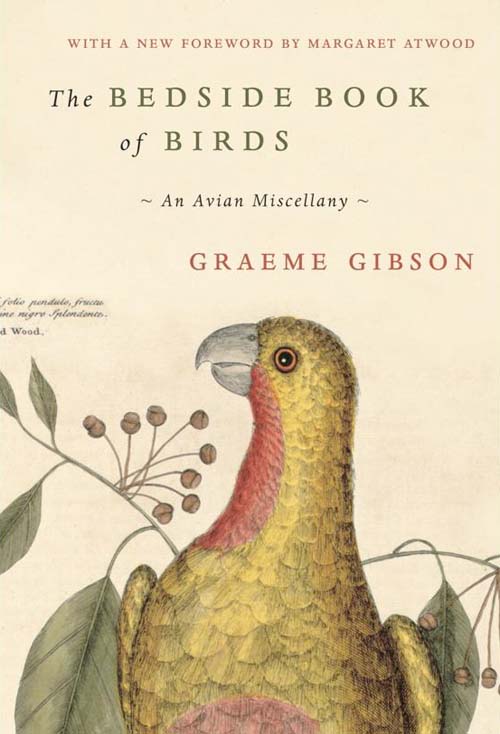 When Margaret Atwood would receive invitations over the years to literary events around the world, literature wasn't the only factor shaping her response. She also kept in mind the interests of her longtime partner and fellow Canadian author Graeme Gibson. When Margaret Atwood would receive invitations over the years to literary events around the world, literature wasn't the only factor shaping her response. She also kept in mind the interests of her longtime partner and fellow Canadian author Graeme Gibson.
“Sometimes I would accept so we could go to the place and watch birds,” she says.
Gibson, who died in 2019 at age 85, was known well beyond the world of books. He was a prominent conservationist and ornithologist who helped found the Pelee Island Bird Observatory, served on the council of the World Wildlife Fund Canada and was honorary president of BirdLife International’s Rare Bird Club. The Royal Canadian Geographical Society awarded him a gold medal in 2015.
Inevitably, his love for birds found its way into his writing. “The Bedside Book of Birds: An Avian Miscellany," an illustrated compilation of folktales, poems, fiction and nonfiction that Gibson had assembled on his own, was originally published in 2005. A surprise bestseller at the time, it has been reissued with a new foreword from Atwood, who called birdwatching a pursuit she and Gibson enjoyed together. “Though if birdwatching were a religion," added Atwood, who spent part of her childhood in the backwoods of Quebec, ”I'd have been the blase communicant who’d grown up in it and performed its rituals because that’s what our people do, and Graeme would have been the new convert, smitten with blinding light on the road to Damascus.” “Every bird was a revelation to him,” she wrote. “A red-tailed hawk! Look at that! Nothing could be more magnificent.” Read more | | | | FILMS Birds Steal the Show in the New Netflix Film 'Penguin Bloom' 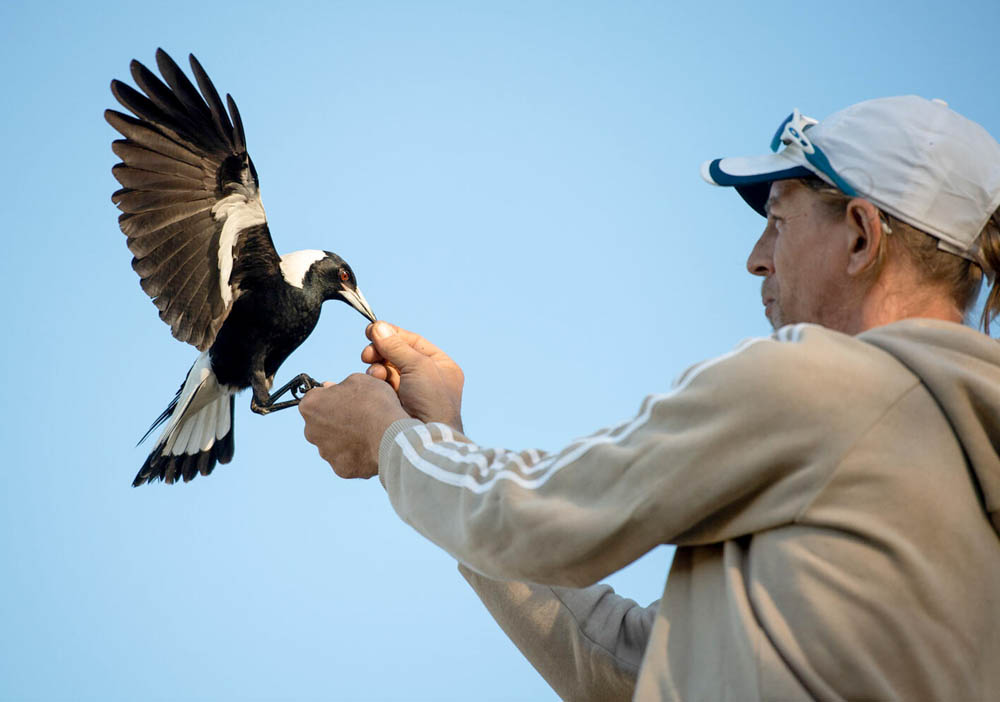 The on-set trainer for the movie, based on an uplifting true story, reveals the challenges and joys of preparing magpies for the screen. The on-set trainer for the movie, based on an uplifting true story, reveals the challenges and joys of preparing magpies for the screen.
Actress Naomi Watts typically doesn’t have to worry about being pooped on by her castmates. But in her latest movie, Penguin Bloom, her co-stars were birds.
“I placed the magpie on Naomi’s head, walked out of shot . . . and pretty much automatically the magpie went to the loo,” says Paul Mander, the bird trainer on set. “It ran all the way down her nose and across her lips and dripped off her chin,” he says. “Nobody really knew how to react to it. As soon as Naomi started laughing, it broke the ice.” The Netflix film, released on January 27, tells the real-life story of the Bloom family. After Sam Bloom, played by Watts, suffered a life-changing injury, she and her family found support and inspiration through a rescued Australian Magpie chick her kids dubbed “Penguin” for her black and white plumage. Mander, who also directs the Broadwings Raptor Training Centre in Brisbane, Australia, has trained and worked with a huge range of species throughout his career but says magpies are especially playful, curious birds. “It makes them great fun to work with,” he says. “They make very good students.” Read more | | | |  The Rachel Carson Council Depends on Tax-deductible Gifts From Concerned Individuals Like You. Please Help If You can. The Rachel Carson Council Depends on Tax-deductible Gifts From Concerned Individuals Like You. Please Help If You can. | | | |  Sign Up Here to Receive the RCC E-News and Other RCC Newsletters, Information and Alerts. Sign Up Here to Receive the RCC E-News and Other RCC Newsletters, Information and Alerts. | | | | | | | | | | | |